Hitchhiking
asking people, usually strangers, for a ride in their road vehicle
Hitchhiking is one of the cheapest ways of traveling. By tradition, hitchhiking is defined as soliciting a ride by standing at the edge of a road, facing traffic, with one's thumb extended/upwards. You can meet a lot of people and make lots of friends. You can also become very frustrated, or encounter danger on the way; today's drivers are more fearful of picking up hitchhikers than in the past. But it's also a great feeling to get a ride after you've been waiting for a long time. People who do pick up hitchhikers tend to be very friendly. However, hitchhikers also risk being picked up by someone who is an unsafe driver or even dangerous to their person.
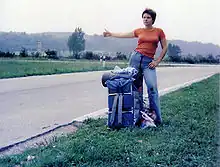
Hitchhiking in itself is rarely illegal, but there are often rules about where you can do it (e.g. not on highways, near intersections, at bus stops), so read up on the rules first to avoid getting booked for "trespassing" or "obstructing traffic".
The Hitchhiking Wiki has a lot of useful information. Read up about the different country articles and use the city articles to get out of bigger cities.
Although hitchhiking is easier in some regions than in others, it is possible to get nearly anywhere by thumb. In some regions you are expected to pay a share of the expenses.
Before
- Be prepared to walk all day. It is not easy and you need to think that it is more of a walking adventure with a chance of getting a ride more than anything else. This is the most unanticipated problem of most hitch-hikers today.
- Therefore, you also have to consider travelling light. To get to the right spot or reach destinations off the main routes, you will most always have to walk a lot—distances of 10 km per day are not uncommon. Hence, instead of carrying 20 kg of everything you deem necessary, better stick with 10 kg of what you will really need. If you travel minimalistically, also pack this way. In addition, some drivers may be reluctant to find space for you and clumsy baggage.
- Have a map of the area, so you can determine whether a ride will actually bring you closer to your destination.
- Learn the language, at least a little. Hitchhiking can be a good way to improve your conversation skills. Often drivers pick up hikers to have some conversation on an otherwise long and lonely trip. Our hitchhiking phrasebook has a few phrases that are useful when boarding and getting off, while Talk is about how to cope with language difficulties more generally.
- Make sure to carry enough food and drink if you're going for a long trip. Gas stations are usually a bit expensive for replenishing these supplies.
- Arrange sleeping places. For example, a hospitality exchange host, a youth hostel, or a squat are good places to start. Your arrival time will need to be flexible as any difficulty in getting a ride will delay your travel. If you cannot arrange a place, take a tent with you, rubberized German poncho, and a warm sleeping bag.
- Hitchhiking may be illegal in some areas or on certain types of roads. Enforcement of laws against hitchhiking may vary. Ask locals. It is usually a bad idea to hitchhike if an encounter with the police would create additional problems (e.g. your visa basis is shaky for what you are doing).
- Dress in layers if the weather is uncertain. Make sure that your heavier layer will shield you from cold winds and random showers, but is light enough that it won't weigh you down too much when you remove it. Some people (for example the "Moscow school of hitchhikers") swear that bright colors with high visibility get you away quicker. See below for other appearance considerations.
- Some hitchhikers recommend taking a foldable bike (which can be stowed in a car's back seat) as back-up transportation.
- Bring a black marker, a hat, a flashlight, a pocketknife, sunscreen, etc. It is best to be prepared and these items do not weigh much.
- A small whiteboard and dry-erase markers make it easy to create a destination board and to change it as needed.
- Depending on the length of your trip, it may be massively useful to bring a towel. There are light ones.
Appearance

You should have clothes and gear for the weather, but you should also think about the impression your clothing gives.
Bright clothes make you stand out, giving drivers more time to react, but do not overdo it, unless you want to look odd.
A short skirt can help women get a ride, but often from drivers you shouldn't accept a ride from. Military-looking clothes can make you look threatening or unsympathetic—although a proper uniform may get you sympathy where conscripts hitchhike home for leave, if you look the part. A suit will make you seem odd—why aren't you hailing a taxi? A more casual outfit is probably better. A pair of light glasses can make you look more nerdy and thus less threatening and more friendly, but covering your face with sunglasses may have the opposite effect. An odd look will turn away some drivers and attract others, which sometimes is good where traffic is abundant but nobody picks you up.
It is probably good to try understanding what people are scared of and what they deem sympathetic and least threatening. This does not vary much around the world, it is mostly always the same fears that are fueled. One thing which may differ is associations with recent or ongoing conflicts: symbols such as a flag, or clothing related to some ethnic or social group, can awaken very different feelings.
People are scared of criminals and bums, and some disdain freeloading and non-working hippies. However, they are happy about tourists from well known and respected countries that bring money into their own country (or otherwise seem sympathetic) and hopefully speak a common language. They are also sympathetic to people who look like they or their children would when hitchhiking. Some will give a ride to people from exciting places or people who seem to have good stories to tell. Use this to you advantage when deciding on a look.
Getting a ride
For hitchhiking long distances, some parts of the world, like parts of North America and Europe, are densely populated and make for easy hitching. Other parts, like Central Asia, have lower traffic and may result in harder transportation.
Location
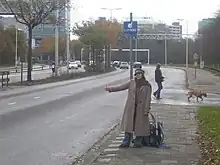
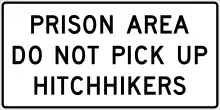
- The three most important factors for getting a ride are: location, location, and location. You need to find a place where you can be seen early (to give the driver time to decide to pick you up), and where the driver can safely pull over. Ideally, there should be some traffic, but not too much, as this makes pulling over difficult and makes drivers assume that you can always get a ride with somebody else.
- Don't try to catch a ride from downtown, instead catch public transport to the edge of town. City drivers are mostly traveling short distances, and it can be difficult for you to stand out or get them to stop in heavy traffic. Check your map, or ask around, to find a good spot.
- If your destination is a large city, first choice is usually to be dropped in a central location near your destination; second choice is a transit-friendly location such as a large mall or a subway/metro station. An outer suburb will typically have fewer public transit options; suburban local bus may require multiple transfers and multiple fares, while a commuter rail station may have no train service outside peak traffic hours.
- For long-distance travel, never get taken into the middle of town! You will most likely find it very difficult to get back out. Get dropped off close to the highway—especially if the main road bypasses the commercial district. For instance, the only suitable location in tiny Wawa might be out beside the big goose on the Trans-Canada Highway.
- Unattended highway rest areas are ill-advised, particularly in the US, due to the number of "disturbing incidents" at these locales... and the reputation for them which leads many motorists to avoid them. Motorists may assume that you were thrown out of a vehicle there.
- An exception to the "rest area" rule is the commercial rest area, "oasis" or "service plaza". These are generally safer as they're staffed businesses with generally more people patronizing them. You will want to purchase a small item so as not to be trespassing on the concessionaires' leased area. A CB radio (to talk to truck drivers, and other people with CB radios passing by on the main line of the highway) is a good tool for service areas. You can purchase a handheld one for around US$40.00 at many truck stops (if you travel internationally, check what channels, if any, can be used abroad).
- The absolute best place to catch a good ride is on a public highway on ramp, near a truck stop, but not on the truck stop property itself, as those are good places to get thrown out of for trespassing. In Northern California (US 101) and in the Seattle area, many highway on-ramps are also bus stops and thus do double duty in regards to catching a ride.
- Land borders where traffic has to stop are great. One caveat to hitching just before a border, however, is that drivers may be wary of transporting you across an international border itself, thus decreasing your chances of catching a ride. You may find better success crossing the border on foot, and hitching from the other side. If you attempt this, be aware of when a border is buffered by a militarized "no-man's land," through which it is illegal to cross on foot or camp, making it crucial to find a ride within this few-hundred-metre stretch of road before dark. The border between Turkey and Greece is one such example. Also, sneaking into countries is an option, albeit an ill-advised and illegal one.
- Fuel stations where many cars stop are good. In some countries, such as Mexico, the attendants may even help you on your journey. It takes a bit more gusto, but there is a much better chance of success if you actually ask someone for a ride. Though, if you are not doing business at the station, there is a possibility of getting thrown off the property. Just be cordial and leave if you are asked to.
- Laybys and roadside picnic areas are good, although less so in the US as roadside picnic areas tend to be in the middle of nowhere.
- Avoid places where drivers cannot easily and legally stop. After a crossroads, where the cars have just picked up speed, many may not want to slow down. However, shortly after traffic lights might be lucky, because drivers have enough time to notice you, namely when they are waiting for a green light.
- Getting a ride at night is very difficult. You might have some luck at a filling station, where people can see you, but realistically you are probably better off camping out for the night and starting off again at first light.
- Local public transit can bypass segments which are not pedestrian-friendly, such as the Windsor-Detroit border crossing, but will typically cost a few dollars.
- Take advice from non-hitchhikers as to the best places for hitching with a grain of salt.
- Check the map for popular tourist spots in the area—Rental car agencies often have good and free maps.
- Some places, like The Netherlands and Cuba have designated hitchhiking points that are signposted (and in Cuba, staffed!)
Attracting a ride
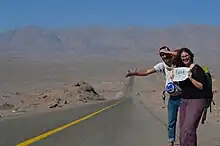
.jpg.webp)
- Asking around doesn't hurt. If people notice you're friendly and speak their language (or one they feel comfortable talking, or one they want to practice) you have a much higher chance of getting a ride from them.
- Make sure you know the right gestures used locally to stop a car. The thumb up sign works in some parts of the world, but has very different meanings in some areas. An outstretched waving arm is another common gesture, but generally defer to locals. Drivers may also use gestures: pointing downwards with the index finger means that they're staying in town. A swirling motion with a downward pointed finger is the same, but can also mean that you might see them again in a minute or so as they make the trip again. A flat hand down means that the car is weighted down, aka full.
- Sometimes walking in the direction you want to go, especially if nobody is stopping to pick you up, can attract rides. It also might bring you closer to your destination and reach other sources of traffic at junctions. On the other hand, if you wander too far from a town, people may wonder what you did to get stranded there, it might be hard to get back in case it gets dark, or put you in an inhospitable environment such as a desert or up in the mountains. Nevertheless, statistically every on-ramp you pass while walking increases the chances of a person going to your final destination passing you, and hitchhiking truly is a numbers game, the more cars that pass you the more likely you are to get a ride.
- Nod or wave thanks to all who at least give you eye contact and especially those who give you gestures explaining why they cannot take you. Not only does it lighten the fear of hitchers and make you feel much better along the way, some may even come back and pick you up. Not to be counted on though.
 Brightly-coloured jacket, big sign... this guy will get to Wakkanai
Brightly-coloured jacket, big sign... this guy will get to Wakkanai - A big cardboard sign with an indication of where you want to go can help. Short general directions like North, or West can be written bigger—and seen from further away—than a longer city or town, but a city is more useful for drivers.
- Nonspecific 'general' directions are really only useful at on-ramps where traffic goes in two directions, like standing before a toll plaza, otherwise, the next town with a truck stop is recommended.
- Avoid writing destinations far away, this gives you a good excuse to get off if you feel uncomfortable with the driver, you can always agree to go further if the driver turns out to be going your way. Also, indicating close destinations will attract short lifts. In Germany 200 km seems to be a good distance.
- It can be a good idea to not indicate your final destination. If you can get a ride in a direction that is not exactly the best one, it could still be a good idea to take it, since you might be able to get more rides from that spot.
- Some people do not believe in direction signs, and suggest funny ones ("I DON'T STINK") or nothing at all.
- Holding your sign upside down may sometimes help to get a ride out of pity.
- If you speak the local language, saying this on your sign may also be useful.
- Some drivers will not stop based on their own racial, cultural, or gender prejudice. While this can be upsetting, consider that you may be better off not riding with such a person.
- If you are travelling with a companion, stand together and make it obvious that you want a ride together. Drivers don't want to be surprised by an extra person. Do not let someone split you up unless you are very desperate.
- Always stay happy and wear a smile—even if people react nastily.
- If you are more of an adventurous type, try hiking around with a large or unusual object. Tony Hawks hiked through Ireland with a fridge and wrote a book about it. It seems to help getting rides and ... there's always something to talk about!
- If hitchhiking in the US, you may want to buy a military-style rucksack at a surplus store. These items are cheap, easily recognizable and can incite interest/sympathy from drivers. If the driver asks about your military background, a white lie such as "my cousin gave it to me" will usually do the trick. Be prepared to have a believable story ready if an explanation is needed. The downside to a military pack is that they're harder to carry than a typical framed backpack.
- Another writer, based on decades of hitching in the US, has developed these rules:
- Wear white or a very light color. It implies cleanliness and is far easier to see, plus the cops react favorably.
- Remember that the driver has only a second to see you. Stand near a highway sign so drivers have a better chance to focus in time to stop.
- If you cannot walk where you're going, don't try. Better to spend some time at a fair spot than waste that time trudging through the boonies.
- If possible, carry your belongings in a large briefcase or similar. You'll be welcome in clean new cars and in places where a duffle bag is inappropriate. Visiting a laundromat pays off in better rides.
- Use signs. A piece of yellow lightweight plastic sign material is ideal, along with strips of black electrical tape to make the letters. A big LA works better than a smaller Los Angeles.
- Do not smoke while trying to catch a ride. Decide which is more important to you.
- Finally, ask yourself: would I pick me up? Think like a driver who might enjoy giving you a ride.
Choosing a ride
- Be aware that solitary male drivers are the most likely to pick you up. Female drivers and families are a possibility, but they are much less likely to stop for you. Nevertheless, they become more likely if you are female.
- If you're waiting for a long time and all the cars that want to take you go in the wrong direction it can be a good idea to let them take you anyway—just to drop you at a better spot.
- Sometimes you get an offer that brings you a little way in the right direction. This can be okay, but if you're at a place where lots of cars stop, it could be a better idea to wait for an offer that brings you a lot further.
- Ask if you can be dropped at a good spot for getting more rides if your ride isn't bringing you to your final destination, e.g. a gas station or a toll place.
- When possible, try to agree on precisely where you'll be dropped off.
Alternatives
- A somewhat more reliable alternative is ride sharing. People who travel long distance advertise their trips on the internet and you can ask for a ride, but you are usually expected to pay. Sites in different countries use different systems, but it is best to find a site which concentrates on long-distance and one-off trips rather than regular commutes. University students and backpackers often need long rides home, so join Facebook groups or forums which cater to them.
- Using a digital system is good for safety as it provides a record of communication between driver and passenger should anything go wrong.
- Getting over bodies of water require somewhat different strategies, see Hitchhiking boats.
Backup
Always have a backup plan in case your hitchhiking is unsuccessful. This may include:
- carrying a tent with you
- knowing or looking up public transport options
- walking to a better place or back to civilisation
- knowing or looking up nearby accommodation options
Cope
Respect
While a mobile telephone and automobile association membership may be all that prevent the average motorist becoming a hitchhiker themselves the next time their vehicle breaks down at roadside, most drivers have their own safety concerns when dealing with hitchhikers. Many will not offer rides at all because they fear a passenger may harm them or steal from them. Others may stop only if they're not already carrying passengers or valuables, or may be hesitant to stop at night or in an unfamiliar area.
There are also road safety issues.
- Make yourself visible from as far a distance as possible. Cars will need a surprisingly long distance to see you, read your sign, decide to stop for you, and come to a stop safely. Vehicles need four times the distance to safely stop on a 100 km/h highway vs. a 50 km/h local road! If you stand on a curve, or in conditions of limited visibility, drivers are even less likely to stop for you. Make it easy for them!
- The driver is doing you a favour by offering you a free ride. Don't abuse their generosity by asking for handouts ("spare some change?") or trying to get them to change their destination for you.
- Smoking can be an awkward issue. Smoking while holding out your thumb will dissuade non-smoking drivers from picking you up. If you're a smoker, don't smoke in your driver's car unless you're invited. Conversely, if you're an asthmatic and your driver is hopelessly addicted to nicotine, you'll either have to put up with it or ask to be let out.
- Border crossings can be problematic. Entering a foreign land is awkward enough; bringing a hitchhiker across an international boundary will give customs and immigration officials a pretext to pick apart the vehicle—and some borders cannot be passed on foot.
- Don't litter. This applies to your hitchhiking spot, and your host's car.
- Don't expect your driver to do anything unsafe or prohibited, such as an illegal U-turn on a divided motorway or a sudden stop to let you disembark in a "no stopping" or "no pedestrians" zone.
- Many drivers who pick up hitchhikers do so for their company, be prepared for a conversation. Be talkative if it seems your driver likes it, but be considerate of when the driver needs to concentrate on the driving or if their body language indicates they want some peace and quiet.
- Lastly, the driver is a complete stranger who is just trying to get safely to their destination. Save the more bizarre enquiries ("I'm an adrenalin junkie; can I ride on top of the car?") for someone who actually knows you and can judge whether this is real or all just some bizarre joke.
Respect is a two-way street. If you are a motorist, you are under no obligation to offer free rides but you are legally and morally responsible for the safety of any passengers you do agree to transport. Operate your vehicle responsibly.. Allow passengers to disembark in safe locations with access to onward transport if they're not within walking distance of the destination.
Scams
It is not unheard of, e.g. in Eastern Europe, that drivers take you for the ride inviting you in, just to turn out to be taxis which demand an exortibantly high fare for their ride. This is different from countries where paying for a ride is the normal practice (see the country table below). It is unlikely to happen for shorter distances, e.g. where you just go a few kilometer to reach a nearby destination.
In a dodgy twist of this scam, the scammer will put up their "taxi" sign ontop of the roof during the ride (e.g. unnoticed at a rest stop or so) and claim it was there all along and you just missed it. While of course he could actually be a taxi (but the missing meter points against that), in no country will a price ever be negotiated at the middle or end of the ride.
Don't get fooled, they will prey upon your innocence!
Red flags include:
- They will pretend the ride is free when you ask how much it is when entering their vehicle.
- A highly inflated proposed fare compared to other costs in that country.
- Only at the last instance they will come up with the topic of payment, putting the blame and pressure upon you.
- They will point to their taxi sign on the roof, and pretend you missed it—even though proper taxis always have a meter.
- When not intending to pay, they will claim to drive to the police. However, while this might sound worrying, the police will more often be on your side.
To avoid:
- Clearly state that you intend to ride for free (in some former Soviet countries, including Turkic-speaking ones, the use of the word autostop might help as well as in Turkey where otostop is better understood) and/or that you do not have any money with you—use a translator.
- Just ask whether they are taxi or say taxi, no! and wait for a confirmation.
- Have all your belonging with you ready, just in case things go badly.
- If there are already other people in the car, it is particularly important that the driver understands your intentions.
In case things still go sideways:
- Demand to be brought to a police station where to settle the issue. Most police station will not be on the taxi driver side and understand that something is wrong.
- Call the police and demand advice, tell them where you are and what is happening, especially when the driver doesn't stop. They might be able to spot you, or at least they got your number.
- Come up with some coins and pretend that this is all you got. If it covers the fuel costs, the scammer will probably back down.
- As a last resort, leave the car at the first instance possible and walk away as quickly as possible, potentially into a direction the scammer cannot follow with his car. At all costs avoid getting brought somewhere where there are more taxi drivers or even friends of the scammer.
- If you get the chance, note down or take a picture of the vehicles licence plate and make a report at the nearest police station.
Don't hope for the help of any other people already in the vehicle. They might be complices or innocent by-standers, you cannot know.
Stay safe
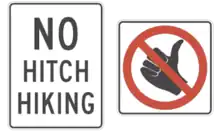
- Take care who you get a ride with. Some criminals prey on hitchhikers. If in doubt, turn down the ride. You can do this non-confrontationally by asking the driver where they're going and telling them you're heading elsewhere.
- Note the vehicle registration, and its make, model, and color before you take a ride. If you have a cellphone, take a photo or text this information to a friend.
- If possible, hitchhike with a friend.
- Choose a car with a single occupant or a couple rather than the last seat in a car full of people.
- Sit in the front passenger seat, if you can. Rear doors often have child locks on them, meaning they cannot be opened from the inside. If you must sit in the back, check the child lock is off before you close the door.
- Keep your bag or backpack in easy reach, so you can grab it if you need to bail out. Be prepared to lose it if it is locked in the trunk.
- Wear at least some of your valuables (i.e. passport, wallet, money, I.D., bank and credit cards, etc.) under or in your clothes, rather than in your pack. Keep them in different places, so that if you lose one item, you don't lose them all. It is a good idea to have your wallet plus two hiding places, an obvious one and a not so obvious one. A good guideline is that criminals will go for your sock before padding up the groin.
- In some places, the police take a dim view of hitchhikers and will arrest you based on the slightest excuse (or at least waste your time by questioning you).
- While pedestrians may have the right to walk along most roads, doing so in some places can get you arrested, cited, ticketed, or verbally warned. Find out about which roads you can and cannot walk along.
- As a general rule, avoid walking along freeways, particularly if it looks unsafe to do so or the jurisdiction you are in prohibits it. In some areas where it is legal to walk on the freeway, it may be wiser and safer to stay on the on-ramp anyway, based on the infrastructure of the road.
- If you arrange a ride through a ride-matching website, you can request the ID number of the driver who offers the ride; give this number to someone at home. Ask for this ID when you meet the driver; most will understand this precaution.
Red flags and advice for women hitchhiking alone
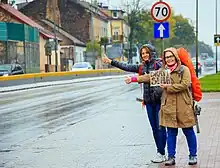
- If a driver goes off the main/right road don't be shy about opening the door while the car is moving. Make an excuse, needing the toilet or to throw up or something. Even being on a period (learn the local word – or just wave a tampon at them in panic, the shock might be enough). Don't waste time if this ever happens. Maybe it's a harmless detour, maybe it's not. Check the map before you leave.
- Persistence! This is a big one, if a man insists you get in the car, firmly walk away. Don't even listen, give a "no, thank you" and turn away.
- Touching. Even in countries where physical contact is more acceptable, do not just brush off unwelcome 'friendly' touching as a cultural difference. Yes, touching is often more accepted outside of the West but not between men and women and rarely between strangers.
- Questions about your route, your internet and your phone.
- Carry a rolling pin strapped to the side of a backpack. This one works surprisingly well. If officials ask about it, you're a keen cook and you like to make 'lavash', or whatever, and it usually just gets a laugh. If you're in real trouble it works as a baton, babushka-style. Hold it on the side away from the driver. Don't carry a knife unless you really know how to use it. Pepper spray can work but in an enclosed space like a car, it'll affect you too, so get out fast, ideally during the spraying.
- If you carry a smartphone or a map, follow it explicitly while they're driving. Even innocently check every so often, "it's straight here, yes?"
- Don't get in a car with multiple men and no women.
- Trucks are generally safer. They have a route to stick to, they're slow so you have time to evaluate a situation, they can't go off onto smaller roads, you sit far away from the driver. Although the negatives are that it's a long jump down from the cab and that the passenger door can be locked from the driver's side.
- Don't hitch risky roads (isolated country lanes, mountain roads, desert etc.) when it's late or you're tired/hungover/drunk or just not at your best. Just take a bus to the nearest town and ask an official if someone has a spare room. People are generally good, you'll find somewhere.
- Don't rely on a wedding ring and a fake husband to help you, even on other women.
- Tie your hair up and don't wear loose clothes that can be grabbed, you want to be able to get out of a car fast.
- If worst comes to worst, a sharp jab to the throat (when the car is slow or stopped) is easy from the passenger side and gives you a little time to get out.
Countries
Below is a map showing the length of time hitchhikers in different parts of the world have reported waiting until they find a ride. The fainter the colour, the less certain the data are for that location, as of April 2024.
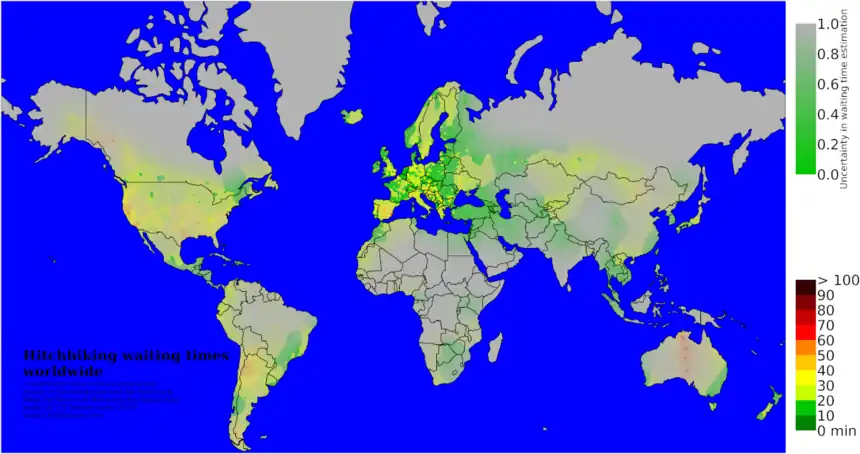
The table below is a briefly lists hitchhiking conditions around the world, ranking countries on four indices:
- whether hitchhiking is popular or even understood, on a scale of common → occasional → rare → unknown
- whether getting rides is generally easy, on a scale of easy → medium → hard → very hard
- whether hitchhiking is legal (outside highways and tollroads, which are nearly universally off limits to foot traffic)
- whether it's possible to hitchhike for free, or whether payment is expected if picked up by a stranger.
"Varies" means that conditions vary dramatically within the country—please consult the country article for details (look for the "by thumb" paragraph in the "get around" section).
| Country | Popularity | Ease | Legal | Payment expected |
|---|---|---|---|---|
| Albania | common | easy | yes | sometimes |
| Argentina | common | easy (south), hard (north) | yes | no |
| Armenia | occasional | easy | yes | no |
| Australia | rare | medium (country), hard (metropolitan) | no (not enforced) | no |
| Austria | occasional | medium | yes | no |
| Azerbaijan | occasional | easy to medium | yes | sometimes |
| Belgium | occasional | easy | yes | no |
| Belarus | occasional | easy | yes | no |
| Bhutan | common | easy | yes | sometimes |
| Bolivia | common | medium | yes | yes |
| Bosnia and Herzegovina | rare | medium | yes | no |
| Brazil | rare | medium | yes | no |
| Bulgaria | rare | easy to medium | yes | no |
| Canada | common | easy | varies | no |
| Cambodia | rare | easy–medium | yes | no |
| Chile | common | medium | yes | no |
| China | occasional | medium to hard | no (not enforced) | sometimes |
| Colombia | occasional | medium to hard | yes | no |
| Costa Rica | rare | medium-easy | yes | no (but offer!) |
| Croatia | common | easy | yes | no |
| Cuba | common | medium-difficult | yes | most of the time |
| Czech Republic | common | medium | yes | no |
| Denmark | rare | easy to medium | yes | no |
| Ecuador | rare | easy | yes | no |
| Estonia | common | easy | yes | no |
| Finland | rare | medium | yes | no |
| France | occasional | easy-medium | yes | no |
| Georgia | occasional | easy | yes | no |
| Germany | occasional | medium to easy | yes | no |
| Greece | rare | medium | yes | no |
| Hong Kong | almost non-existent | hard | no | no |
| Hungary | common | easy | yes | no |
| Iceland | common | easy | yes | no |
| India | rare | medium | yes | sometimes |
| Indonesia | rare | medium to hard | yes | often |
| Iran | medium | easy | yes | yes |
| Ireland | common | easy | yes | no |
| Israel | common | medium | yes | no |
| Italy | occasional | hard | yes | no |
| Japan | rare | easy | yes | no |
| Jordan | common | easy | yes | no |
| Kazakhstan | common | easy | yes | often |
| Kyrgyzstan | rare | easy | yes | 50/50 (less often from tourists) |
| Latvia | common | easy | yes | no |
| Lithuania | common | easy | yes | no |
| Luxembourg | rare | easy to hard | yes | no |
| Malaysia | rare | medium | yes | no |
| Mexico | varies | easy | yes | often |
| Moldova | common | easy | yes | sometimes |
| Mongolia | rare | hard | yes | often |
| Montenegro | common | easy | yes | no |
| Morocco | rare | medium | yes | most of the time |
| Myanmar (Burma) | rare | hard | yes (illegal for foreigners) | no |
| Netherlands | occasional | medium-easy | yes | no |
| New Caledonia | common | easy | yes | no |
| New Zealand | occasional | easy | yes | no |
| Nicaragua | common | easy | yes | no |
| Nigeria | occasional | easy | yes | yes |
| Norway | common in summer | medium | yes | no |
| Paraguay | rare | easy to medium | yes | barely |
| Peru | rare | hard | yes | sometimes |
| Philippines | rare | medium | yes | no |
| Poland | common | medium to easy | yes | no |
| Portugal | occasional | hard | yes | no |
| Romania | common | medium | yes | often |
| Russia | common | medium | yes | often |
| Serbia | common | medium | yes | no |
| Singapore | almost non-existent | very hard | no | no |
| Slovakia | common | medium | yes | no |
| Slovenia | common | easy | yes | no |
| South Africa | common | depends | yes | yes (price of minibuses) |
| South Korea | rare | easy | yes | no |
| Spain | occasional | medium | yes | no |
| Sweden | occasional | medium | yes | no |
| Switzerland | occasional | easy-medium | yes | no |
| Taiwan | rare | easy | yes | no |
| Tahiti | common | easy | yes | no |
| Thailand | occasional | easy-medium | yes | no, unless you are getting ripped off |
| Turkey | occasional | easy (hard to impossible in urban centers) | yes | no |
| Ukraine | common | medium | yes | sometimes |
| United Kingdom | occasional | easy-medium (but hard in Wales) | yes | no |
| USA | rare | varies | varies | no |
| Uruguay | common | medium to easy | yes | no |
| Uzbekistan | common | easy | yes | usually |
| Country | Popularity | Ease | Legal | Payment expected |